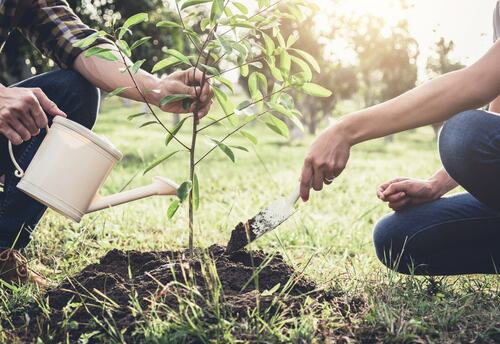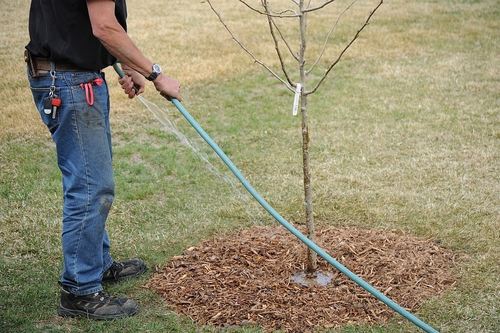Why Spring is the Best Time to Plant Trees
Introduction
Planting trees is a vital step in cultivating a thriving, healthy landscape, and timing is everything. For those in the know, spring is widely recognized as the best time to plant trees. The reason? Planting a tree in the spring allows it to establish roots sooner, grow more robustly, and better withstand the heat of summer. This is especially true when dealing with bare-root stock, but even trees grown in containers or wrapped in burlap benefit significantly from spring planting. Below, we’ll explore why spring is ideal for tree planting and provide expert tips to ensure your trees thrive.
The Benefits of Spring Planting

Two People Plant a Young Sapling
Optimal Growth and Establishment
Spring planting gives trees a head start, allowing them to establish their root systems before the intense heat of summer. Trees planted in spring can take advantage of the mild weather to grow stronger roots, which are crucial for long-term health. This early establishment period makes trees more resilient during the hot and often dry summer months.
Ideal for Bare-root Stock
Bare-root trees , which are sold without soil around their roots, are particularly sensitive and benefit the most from spring planting. Since these trees are dormant when planted, they can immediately begin root development as the soil warms up. While encapsulated and container-grown trees can be planted throughout the growing season, bare-root stock needs the extra growing time that spring provides to thrive.
Spring Planting Tips for Success

A Cherry Tree in Full Springtime Bloom
Planting a tree in spring isn’t just about digging a hole and dropping the tree in. Proper technique is essential for the tree’s survival and growth. Here are some expert tips to ensure successful tree planting in spring.
Protect Trees During Transport
During transport, it’s critical to protect trees from wind exposure, drying out, and rough handling. Ensuring the tree’s roots and branches are not damaged during transport will make a big difference in its ability to adapt to its new environment.
Preparing the Planting Site
When preparing the planting hole, make sure it’s at least two feet wider than the tree’s root ball. This extra space gives the roots room to spread out and establish. The tree should be planted slightly higher—about an inch—than it was in its container to account for settling. After placing the tree in the hole, remove any air pockets by watering and packing the soil. Use a combination of native soil and soil enhancements like natural compost or topsoil to fill the hole.
Fertilizing and Mulching
Avoid fertilizing the tree directly at the time of planting; instead, wait about a year to allow the tree to establish itself. Fertilizing too soon can burn the roots or promote top growth at the expense of root development. Mulching around the base of the tree helps retain moisture and protect the roots, but make sure to keep mulch away from the trunk to prevent rot and pest issues.
Special Consideration for Bare-root and Packaged Trees
For bare-root and packaged trees, spread the roots gently before adding soil. As you fill the hole, lift the tree slightly to ensure it sits at the correct depth. Watering the soil when the hole is about three-quarters full helps eliminate air pockets, which can cause root drying and reduce stability. Finish by adding more soil and watering again.
Balled and Burlapped Trees
When planting trees that are balled and wrapped in burlap , handle them by the root ball rather than the trunk to avoid damaging the tree. Once in place, remove all twine and pull the burlap away from the trunk. Ensure no burlap is left above ground, as it can wick moisture away from the roots. Backfill the hole with soil, water thoroughly, and then add the remaining soil.
Encapsulated and Container-Grown Trees
For encapsulated and container-grown trees , carefully inspect the roots before planting. If the roots have started to grow in a circular pattern (a condition known as girdling), make vertical cuts on the sides of the root ball to encourage outward growth. A crisscross cut on the bottom of the root ball can also help prevent root-bound trees. Plant as you would a balled or burlapped tree, ensuring the tree is secure and well watered.
Ongoing Care After Planting

A Young Tree is Mulched and Watered Deeply
Watering for Establishment
Consistent watering is crucial during the first growing season. Rather than short, frequent watering sessions, which can lead to shallow roots, opt for a slow, deep watering method. Allowing water to soak the soil deeply encourages roots to grow downward, making the tree more drought resistant in the future.
Pest and Disease Management
Newly planted trees are vulnerable to pests and diseases, so regular monitoring is essential. For small trees, manually remove caterpillars or use a strong spray of water to dislodge aphids and spider mites. Early detection and treatment can prevent minor problems from becoming serious threats to the tree’s health.
Professional Assistance for Tree Planting
Planting trees requires care, attention, and knowledge to ensure they thrive for years to come. If you’re unsure about the best practices or need assistance with planting new trees, it’s wise to consult a professional. In the greater San Francisco Bay Area, Arborist Now is the premier tree care specialist. Our team of experts can help you with all aspects of tree planting and care. Contact us today to schedule a consultation and give your new trees the best start possible!
Originally posted on March 16, 2021.


